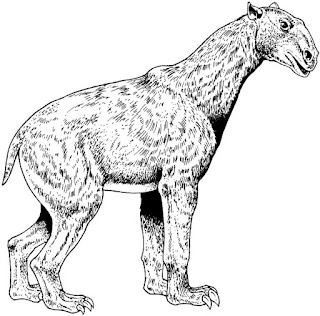As one of the
strangest mammals in prehistory, Chalicotherium
has baffled paleontologists for a long time.
When fossils were first found of this animal, naturalists thought that
She had to be a predator. What they had discovered
were the long sharp claws of Chalicotherium. Since She had no modern descendents to guide
them, paleontologists decided to place Chalicotherium
with carnivore-like Mammals.
However when more fossils were discovered,
scientists realized that Chalicotherium
had no teeth in her upper jaw. Moreover,
fossilized teeth from this Mammal of the Miocene epoch showed very little
wear. Scientists decided that She ate
only the tender shoots from the trees.
Chalicotherium
walked on her knuckles like modern Gorilla and sat on her haunches like modern
Panda. When She walked, her back sloped downwards
because of the difference between her long front legs and short strong hind
legs. When Chalicotherium ate, She would use her long legs as her arms to
grasp the leaves on trees. Then She used
her razor sharp claws to slice off tender shoots from the trees. After Chalicotherium
placed the leaves in the back of her mouth, She would sit down and chew on them.
Chalicotherium
was unusual since She was an Odd-toed Mammal (Perissodactyl) who had claws
instead of hooves. A distant relative of
modern Tapirs and Rhinos, She looked like a cross between a modern Horse and an
extinct Giant Ground Sloth. Unlike the
other hoofed Mammals, Chalicotherium
regressed back to the original toes of her ancestors. This is the only known instance of a hoofed
Mammal who reverted back to the original clawed toes.
The extinct Mammal Family that Chalicotherium belongs to is the
Chalicotheres. Knuckle-walkers like Her are
called the Chalicotheriinae (after Her).
Meanwhile, her relatives known as the Schizotheriinae
(such as Ancylotherium) walked on
flat feet. The Schizotheriinae lived in
Africa amongst the early Hominds.
During the Pliocene epoch, Chalicotherium
went extinct as more versatile plant eaters emerged. However, some people believe that She still
lives in Africa. There are stories of a
strange Animal with long claws for limbs and a horse-like face living in the
jungles. Other people theorize that the elusive
Nandi Bear of Kenya could be Chalicotherium. However, the tales of Nandi Bear depict a
fearsome predator, while Chalicotherium
was a gentle-soul who ate tender leaves.
Since She was not in a hurry to go anywhere, Chalicotherium valued slow time.
Instead, this large Mammal preferred to sit still and eat tender tree
shoots. Moreover She turned back time by
reverting to the claws of her ancestors instead of retaining the more modern hooves. When people rushed to judgment about Chalicotherium, they thought that She
was a deadly predator. With the slowness
of time, people realized that Chalicotherium
was a quiet plant eater. When the world
becomes too fast, let Her show you how to slow down. Appreciate as She does – the calmness and serenity
of slow time.
-----------
-----------







